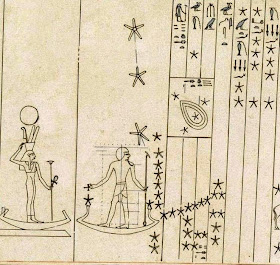Uno tra i tanti e affascinanti misteri che circondano il mito dell’antico Egitto è il soffitto della tomba di Senenmut.
Senenmut era un uomo di grande sapienza, che aveva ottime conoscenze di astronomia che sono ancora oggi riscontrabili nel suo piccolo sepolcro che costruì a Deir el-Bahari vicino al tempio di Hatshepsut, ma nel quale non fu mai stranamente sepolto.
 |
| disegni di Senenmut |
In questa tomba è stato scoperto un importante dipinto fatto sul soffitto e ricoperto poco dopo con dell’intonaco, con l’intento di nasconderlo completamente per poterlo tramandare probabilmente meglio ai posteri e questo fa pensare che nascondesse dei grandi segreti.
Sul soffitto sono illustrati dei disegni che mostrano i dodici mesi dell’anno rappresentati da dei cerchi suddivisi in tre gruppi, e composti da ventiquattro spicchi.
Il dipinto raffigura il cielo, in modo preciso e dettagliato, dimostrando che Senenmut era in possesso di straordinarie conoscenze astronomiche.
Nella parte dell’immagine in cui sono raffigurate le tre stelle della Cintura di Orione, c’è un dettaglio che attira subito l’attenzione, si tratta della stella centrale la quale è circondata da tre ellissi a forma di goccia, una dentro l’altra, che la mettono in evidenza.
 |
| disegni di Senenmut |
Questa particolarità ha fatto porre delle domande ai ricercatori in quanto questo tipo di simbologia non era usata nelle rappresentazioni della scrittura Egizia, ma piuttosto dai popoli Mesopotamici i quali usavano indicare in questo modo l’acqua e la vita.
Inoltre poiché recentemente la Nasa ha scoperto attraverso il Telescopio Herschel che nella costellazione di Orione c’è la presenza di molecole di ossigeno, le quali potrebbero aver dato luogo alla formazione di acqua.
Qualcuno ha ipotizzato che Senenmut fosse in possesso di grandi segreti e che avesse voluto tramandare queste conoscenze ai posteri in quel modo, indicando nel disegno la presenza di vita nella costellazione di Orione, e questo misterioso dipinto così accuratamente nascosto sotto l’intonaco, rafforza tale ipotesi.
The mystery of Senenmut’s drawings
One of the many and fascinating mysteries surrounding the myth of ancient Egypt is the ceiling of the tomb of Senenmut. Senenmut was a man of great wisdom, who had excellent knowledge of astronomy which can still be found today in his small tomb he built in Deir el-Bahari near the temple of Hatshepsut, but in which he was never strangely buried. Senenmut drawings Senenmut drawings In this tomb an important painting was discovered made on the ceiling and covered shortly after with plaster, with the intention of completely hiding it in order to probably be better handed down to posterity and this suggests that it hid great secrets. On the ceiling are illustrated drawings showing the twelve months of the year represented by circles divided into three groups, and composed of twenty-four segments. The painting depicts the sky, in a precise and detailed manner, showing that Senenmut was in possession of extraordinary astronomical knowledge. In the part of the image in which the three stars of the Orion Belt are depicted, there is a detail that immediately attracts attention, it is the central star which is surrounded by three drop-shaped ellipses, one inside the other, which highlight it. Senenmut drawings Senenmut drawings This peculiarity made the researchers ask questions as this type of symbology was not used in representations of Egyptian writing, but rather by the Mesopotamian peoples who used to indicate water and life in this way. Furthermore, since recently NASA has discovered through the Herschel telescope that in the Orion constellation there is the presence of oxygen molecules, which could have given rise to the formation of water. Some have suggested that Senenmut was in possession of great secrets and that he wanted to pass on this knowledge to posterity in that way, indicating in the drawing the presence of life in the constellation of Orion, and this mysterious painting so carefully hidden under the plaster, reinforces this hypothesis.
